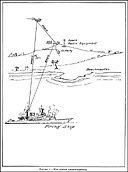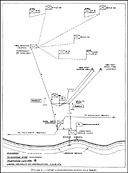
Chapter VII
Communications
| Section | Page | |
|---|---|---|
| I. | General | 161 |
| II. | Ship to shore movement | 162 |
| III. | Communication between ship and shore | 164 |
| IV. | Initiation of the shore communication system | 169 |
Section I
General
| Par. | ||
|---|---|---|
| 701. | Scope | 161 |
| 702. | Communications in landing operations | 161 |
| 703. | Communication officer of landing force | 161 |
| 704. | Personnel, additional | 161 |
| 705. | Equipment, additional | 161 |
| 706. | Utilization of signal agencies | 162 |
| 707. | Parallel systems | 162 |
| 708. | Reduction in traffic | 162 |
- Scope.-- This chapter deals only with those phases of naval communications which are directly involved in a landing operation and which differ from, or are in addition to, normal naval and military communication requirements.
- Communications in landing operations.-- Landing operations present problems in communication which differ in many respects from those encountered in other types of fleet or field operations. The large number of task groups involved in a landing operation places a heavy burden on all communication agencies. The necessity of coordinating and linking communication systems afloat and ashore requires careful planning and consideration of the operation as a whole. Special training is required and additional personnel must be provided for certain activities not elsewhere encountered, such as, for example, the control of naval gunfire from the shore. The nature of the operation is such that great dependence must be placed on the communication system; adequate and efficient communications are prerequisite to success.
- Communication officer of landing force.-- The communication officer of the landing force has the same status as the communication officer of any task group within the attack force. He should consult with the communication officer on the staff of the attack force commander in the preparation of the communication plan for the landing force. He should also be prepared to advise the communication officer on the staff of the attack force commander with regard to communication requirements not normally encountered in naval operations, but which should be included in the attack force communication plan.
- Personnel, additional.-- The attack force communication plan must make provision for furnishing the additional communication personnel required. Additional radio operators and visual signalmen may be necessary, as follows:
- Equipment additional.--
-
The attack force communication plan must make provision
for the procurement and proper distribution of signal matériel not normally provided, for example:
Radio sets for boats, for vessels of control group, for beachmaster, or fire control parties ashore, and for transports.
Pyrotechnics for boats and for control vessels.
Designating flags or lights for control vessels.
Semaphore and guide flags for boats.
Blinker tubes for boats.
On transports.
On control vessels.
By boat group, boat division, and wave commanders.
By the beachmaster.
By fire control parties ashore.

